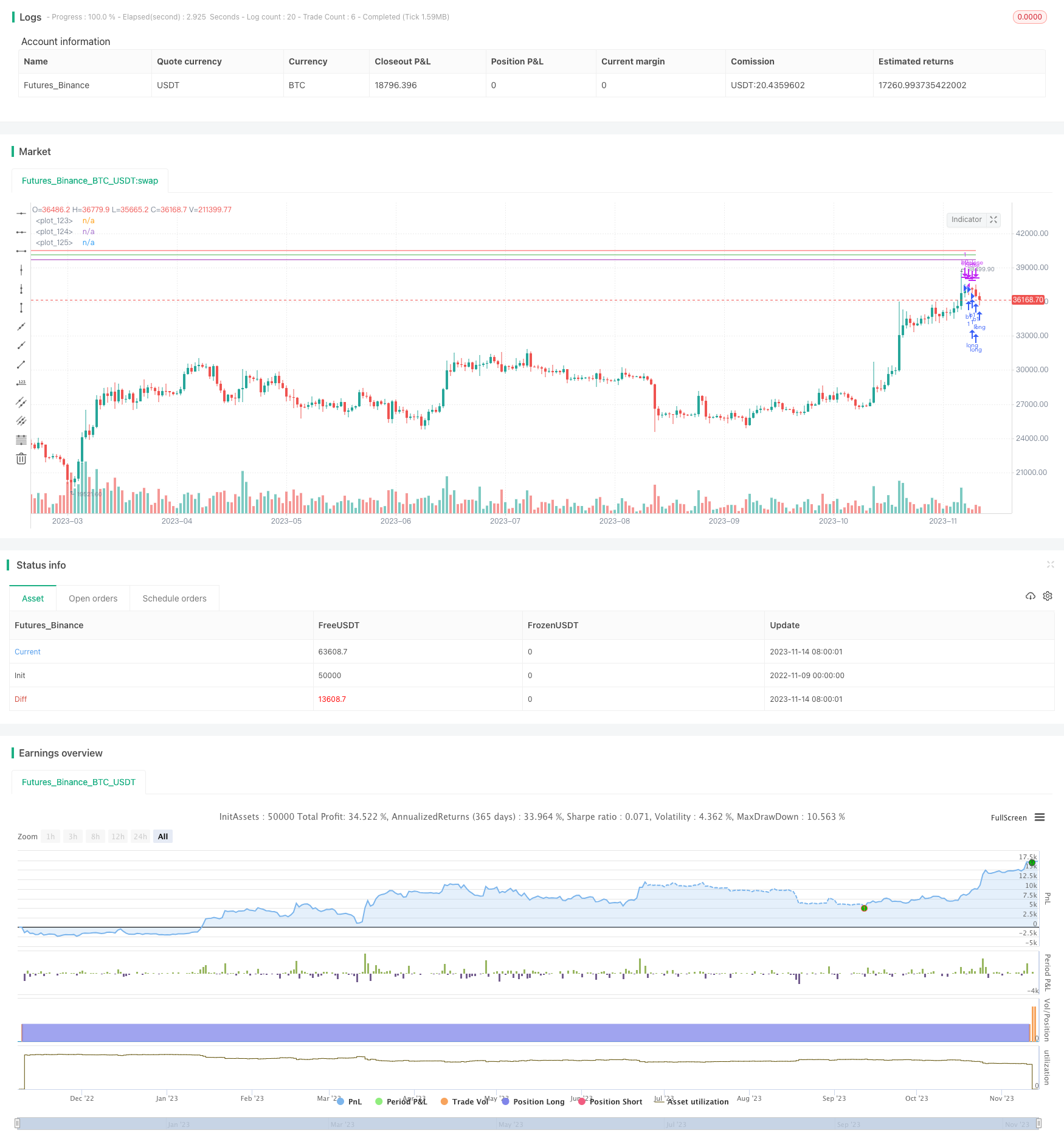
概述
本策略采用固定网格交易的方式,设置起始价格和每层网格间距比例,然后根据这个比例设置10层固定买入和卖出价格,实现低买高卖的网格交易策略。
策略原理
该策略首先设置起始价格sprice和每层网格间距比例gridpercent。然后根据起始价格和比例计算出10层买入和卖出价格。
买入价格公式:
b1=sprice-(sprice*p1)
b2=sprice-(sprice*p2)
b3=sprice-(sprice*p3)
…
其中p1~p10是根据gridpercent逐层计算出来的比例。
卖出价格公式:
s1=b1+(sprice*p1)
s2=b2+(sprice*p1)
s3=b3+(sprice*p1)
…
买入条件是当收盘价低于对应的买入价格时就会触发买入:
if (close
strategy.entry(“b1”, strategy.long, when=(close
同理,当收盘价高于对应的卖出价格时就会触发卖出:
if (close>s1)
strategy.exit(“b1”, when=(close>s1))
这样就实现了固定网格的低买高卖策略。
策略优势
这种固定网格策略具有以下几个优势:
实现了自动的低买高卖,不需要 timing 市场,降低了交易难度。
设置合理的网格间距可以有效控制风险,避免追涨杀跌。
无论行情是上涨还是下跌,都可以实现盈利。
可以通过调整网格参数来适应不同市场行情。
可以通过增加网格层数来扩大持仓规模。
可以结合止损来避免极端行情的巨额亏损。
策略风险
该策略也存在一些风险:
行情横盘时,交易费用会磨掉利润。
起始价格和网格设置不当时,容易亏损。
突发事件造成价格跳空跌时,可能导致亏损。
机械交易系统有交易插队风险。
集中爆发事件导致亏损扩大。
对应的解决方法:
合理设置网格参数,确保盈利大于交易费用。
通过回测优化参数,设置合适的起始价格和网格间距。
增加止损来控制风险。
适当放宽交易价格来避免插队。
设置风险控制,限制最大亏损。
策略优化
该策略可以从以下几个方向进行优化:
动态调整网格间距,当波动加大时扩大间距,减小间距。
根据历史数据计算波动范围,动态调整起始价格。
加入机器学习模型,预测价格走势,动态调整网格。
在高风险点加入止损,通过观察历史止损点来优化止损位置。
结合资金管理策略,根据利润情况动态调整仓位。
优化仓位管理,最大化资金利用效率。
优化交易执行,使用TWAP等算法减少冲击成本。
总结
本策略采用固定网格交易的方式,根据起始价格和网格间距比例设置买入卖出价格,实现自动化的低买高卖交易,可以有效利用行情波动获利。同时也要注意风险控制,通过参数优化、动态调整和止损来锁定利润和控制亏损。结合先进的机器学习和资金管理手段,可以进一步提高策略收益率和胜率。
/*backtest
start: 2022-11-09 00:00:00
end: 2023-11-15 00:00:00
period: 1d
basePeriod: 1h
exchanges: [{"eid":"Futures_Binance","currency":"BTC_USDT"}]
*/
// This source code is subject to the terms of the Mozilla Public License 2.0 at https://mozilla.org/MPL/2.0/
// © Lionkind
//@version=5
strategy("Grid HW", overlay = true, margin_long = 1, margin_short = 1)
// Fix 35k price as starting point and 1% as a distance
sprice=input(40500,"Starting price")
gridpercent=input(1,"Percent")
// calculate the % of the 10 layers
p1=((gridpercent*1)/100)
p2=((gridpercent*2)/100)
p3=((gridpercent*3)/100)
p4=((gridpercent*4)/100)
p5=((gridpercent*5)/100)
p6=((gridpercent*6)/100)
p7=((gridpercent*7)/100)
p8=((gridpercent*8)/100)
p9=((gridpercent*9)/100)
p10=((gridpercent*10)/100)
//set buy prices
b1=sprice-(sprice*p1)
b2=sprice-(sprice*p2)
b3=sprice-(sprice*p3)
b4=sprice-(sprice*p4)
b5=sprice-(sprice*p5)
b6=sprice-(sprice*p6)
b7=sprice-(sprice*p7)
b8=sprice-(sprice*p8)
b9=sprice-(sprice*p9)
b10=sprice-(sprice*p10)
//set sell prices
s1=b1+(sprice*p1)
s2=b2+(sprice*p1)
s3=b3+(sprice*p1)
s4=b4+(sprice*p1)
s5=b5+(sprice*p1)
s6=b6+(sprice*p1)
s7=b7+(sprice*p1)
s8=b8+(sprice*p1)
s9=b9+(sprice*p1)
s10=b10+(sprice*p1)
//Long conditions
lc1=close<b1
lc2=close<b2
lc3=close<b3
lc4=close<b4
lc5=close<b5
lc6=close<b6
lc7=close<b7
lc8=close<b8
lc9=close<b9
lc10=close<b10
//exit conditions
ec1=close>s1
ec2=close>s2
ec3=close>s3
ec4=close>s4
ec5=close>s5
ec6=close>s6
ec7=close>s7
ec8=close>s8
ec9=close>s9
ec10=close>s10
//long orders
if (lc1)
strategy.entry("b1", strategy.long, when=(lc1))
if (lc2)
strategy.entry("b2", strategy.long, when=(lc2))
if (lc3)
strategy.entry("b3", strategy.long, when=(lc3))
if (lc4)
strategy.entry("b4", strategy.long, when=(lc4))
if (lc5)
strategy.entry("b5", strategy.long, when=(lc5))
if (lc6)
strategy.entry("b6", strategy.long, when=(lc6))
if (lc7)
strategy.entry("b7", strategy.long, when=(lc7))
if (lc8)
strategy.entry("b8", strategy.long, when=(lc8))
if (lc9)
strategy.entry("b9", strategy.long, when=(lc9))
if (lc10)
strategy.entry("b10", strategy.long, when=(lc10))
//exit orders
if (ec1)
strategy.exit("b1", when=(ec1), limit=1)
if (ec2)
strategy.exit("b2", when=(ec2), limit=1)
if (ec3)
strategy.exit("b3", when=(ec3), limit=1)
if (ec4)
strategy.exit("b4", when=(ec4), limit=1)
if (ec5)
strategy.exit("b5", when=(ec5), limit=1)
if (ec6)
strategy.exit("b6", when=(ec6), limit=1)
if (ec7)
strategy.exit("b7", when=(ec7), limit=1)
if (ec8)
strategy.exit("b8", when=(ec8), limit=1)
if (ec9)
strategy.exit("b9", when=(ec9), limit=1)
if (ec10)
strategy.exit("b10", when=(ec10), limit=1)
plot(b1,color=color.green)
plot(s1, color=color.red)
plot(b2, color=color.purple)